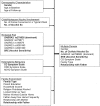Multiple-domain predictors of problematic alcohol use in young adulthood
- PMID: 18781239
- PMCID: PMC2575389
- DOI: 10.15288/jsad.2008.69.649
Multiple-domain predictors of problematic alcohol use in young adulthood
Abstract
Objective: The goal of this study was to identify predictors of problematic young adult alcohol use.
Method: The sample consisted of 141 subjects (81 females) participating in a national study of genetic risk factors for alcoholism. All subjects were evaluated first as children or adolescents, then approximately 5 years later as young adults. Outcome consisted of the number of alcohol symptoms (0-10) endorsed at this second time point. Predictors of outcome were drawn from five domains representing: (1) Demographic Characteristics, (2) Child/Adolescent Problematic Alcohol Use, (3) Biological Risk, (4) Externalizing Behaviors, and (5) Family Environment. A two-stage analytic strategy was used in which (1) separate multiple regression analyses were conducted within each of the five domains and (2) statistically significant predictors of problematic alcohol use from each domain were combined into one regression model to determine which remained significant.
Results: In the final model, 31% of the variance in the number of alcohol symptoms in young adulthood was predicted by a high number of alcohol symptoms in childhood and adolescence, low initial sensitivity to alcohol, and a negative child/adolescent relationship with the father.
Conclusions: These results demonstrated that GABRA2--originally associated with a diagnosis of alcohol dependence in adults--also predicted the onset of symptoms among subjects in their 20s, confirmed specific hypotheses about three other predictors in the fi nal model, and suggested the utility of incorporating biological and nonbiological predictors to optimally predict young adult alcohol problems.
Figures

Similar articles
-
Childhood and adolescent predictors of heavy episodic drinking and alcohol use disorder at ages 21 and 33: a domain-specific cumulative risk model.J Stud Alcohol Drugs. 2014 Jul;75(4):684-94. doi: 10.15288/jsad.2014.75.684. J Stud Alcohol Drugs. 2014. PMID: 24988267 Free PMC article.
-
Polygenic risk score for problematic alcohol use predicts heavy drinking and alcohol use disorder symptoms in young adulthood after accounting for adolescent alcohol use and parental alcohol use disorder.Drug Alcohol Depend. 2023 Jul 1;248:109909. doi: 10.1016/j.drugalcdep.2023.109909. Epub 2023 Apr 29. Drug Alcohol Depend. 2023. PMID: 37163864 Free PMC article.
-
Which adolescent factors predict alcohol misuse in young adulthood? A co-twin comparisons study.Addiction. 2020 May;115(5):877-887. doi: 10.1111/add.14888. Epub 2020 Jan 8. Addiction. 2020. PMID: 31746044 Free PMC article.
-
Sensitive periods for adolescent alcohol use initiation: predicting the lifetime occurrence and chronicity of alcohol problems in adulthood.J Stud Alcohol Drugs. 2011 Mar;72(2):221-31. doi: 10.15288/jsad.2011.72.221. J Stud Alcohol Drugs. 2011. PMID: 21388595 Free PMC article.
-
Meta-Analysis of the Association of Alcohol-Related Social Media Use with Alcohol Consumption and Alcohol-Related Problems in Adolescents and Young Adults.Alcohol Clin Exp Res. 2018 Jun;42(6):978-986. doi: 10.1111/acer.13642. Epub 2018 May 22. Alcohol Clin Exp Res. 2018. PMID: 29786874 Free PMC article.
Cited by
-
P300 and the stroop effect in overweight minority adolescents.Neuropsychobiology. 2010;61(4):180-7. doi: 10.1159/000297735. Epub 2010 Mar 18. Neuropsychobiology. 2010. PMID: 20299812 Free PMC article.
-
Genes associated with alcohol outcomes show enrichment of effects with broad externalizing and impulsivity phenotypes in an independent sample.J Stud Alcohol Drugs. 2015 Jan;76(1):38-46. J Stud Alcohol Drugs. 2015. PMID: 25486392 Free PMC article. Clinical Trial.
-
α2-containing GABA(A) receptors: a target for the development of novel treatment strategies for CNS disorders.Pharmacol Ther. 2012 Nov;136(2):142-52. doi: 10.1016/j.pharmthera.2012.08.006. Epub 2012 Aug 18. Pharmacol Ther. 2012. PMID: 22921455 Free PMC article. Review.
-
Childhood and adolescent predictors of heavy episodic drinking and alcohol use disorder at ages 21 and 33: a domain-specific cumulative risk model.J Stud Alcohol Drugs. 2014 Jul;75(4):684-94. doi: 10.15288/jsad.2014.75.684. J Stud Alcohol Drugs. 2014. PMID: 24988267 Free PMC article.
-
Parental relationship satisfaction in French young adults associated with alcohol abuse and dependence.Addict Behav. 2012 Mar;37(3):313-7. doi: 10.1016/j.addbeh.2011.10.008. Epub 2011 Oct 18. Addict Behav. 2012. PMID: 22088856 Free PMC article.
References
-
- Agresti A. Categorical Data Analysis. 2nd Edition. New York: John Wiley & Sons; 2002.
-
- American Psychiatric Association. Diagnostic and Statistical Manual of Mental Disorders (DSM-III-R) Washington, DC: 1987.
-
- American Psychiatric Association. Diagnostic and Statistical Manual of Mental Disorders, Text Revision (DSM-IV-TR) Washington, DC: 2000.
-
- Begleiter H, Porjesz B. What is inherited in the predisposition toward alcoholism? A proposed model. Alcsm Clin. Exp. Res. 1999;23:1125–1135. - PubMed
-
- Begleiter H, Reich T, Hesselbrock V, Porjesz B, Li T-K, Schuckit MA, Edenberg HJ, Rice JP. The collaborative study on the genetics of alcoholism. Alcohol Hlth Res. World. 1995;19:228–236.
Publication types
MeSH terms
Substances
Grants and funding
LinkOut - more resources
Full Text Sources
Other Literature Sources
Medical

